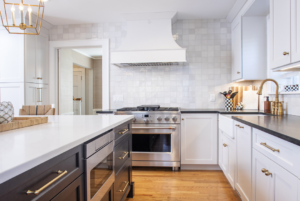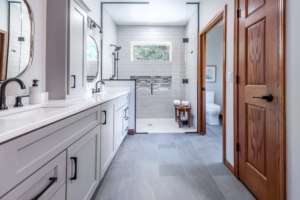Planning a Successful Kitchen Remodel
The kitchen is one of the most important rooms in your home. It should reflect your style & be functional.
Kitchen remodeling is an excellent way to make your home more attractive. However, you must be careful not to over-remodel. You could spend a lot of money and not get the return you’re looking for. Contact Kitchen Remodel Tacoma now!

When you have a kitchen remodel in the works, you need to find a way to cook and store food during construction. Creating a temporary kitchen in a room outside of the construction zone is a great way to continue enjoying meals while your home is being updated. It can be challenging, but thoughtful planning and creative solutions can make this transition much less stressful.
When designing your temporary kitchen, it is important to consider your household’s size and needs. Large families may require more storage space, counter space, and appliances than a smaller household. It’s also important to consider dietary requirements when planning meals. For example, if someone in your family has a gluten intolerance or other allergy, you’ll need to stock up on alternative cooking supplies.
Choosing a location for your temporary kitchen is another crucial step in the process. You’ll want to choose a spot that is tucked away from the construction area and convenient for your family. Typically, a spare bedroom or the family room are good candidates. However, you should make sure that the room is well-ventilated and protected from dust and debris during construction.
Once you have a location, you’ll need to set up your temporary kitchen space and start shopping for necessary supplies. It’s a good idea to plan ahead and buy all of the ingredients you need, including canned goods and frozen foods. This will help ensure that you can prepare your favorite recipes and avoid dining out during the remodel.
When shopping for kitchen equipment, look for items that are compact and easy to use. For example, a small crockpot can be used to make soups or stews, and an electric hot plate is perfect for warming leftovers and making toast. You’ll also need to purchase a trash can, cleaning supplies, and dish towels.
If possible, try to reuse as many kitchen supplies as you can during the remodel. For example, a countertop can be made out of an old table or a sheet of plywood. You can also use slim rolling carts to store dishes and other supplies.
Choosing a Layout
The kitchen layout you choose will make a big difference in the way your space functions. While it may seem like a minor detail, the layout is important because it influences how you and others use the room. It also determines where your appliances are placed and whether they fit in your space. Before you start selecting colors and cabinets, take the time to think about how you will use the kitchen and what your goals are for the space.
There are six different kitchen layouts you can choose from: galley, L-shaped, U-shaped, island, peninsula, and eat-in. Each has its own benefits and can work well in different spaces, but you should always consider your own lifestyle before deciding which one will be best for you.
For example, if you entertain often, an open-concept kitchen with an island is ideal for mingling with guests while cooking. If you’re a family of multiple cooks, an L-shaped kitchen will give each cook ample space to do their jobs without interfering with each other. On the other hand, if you’re a solo chef who only uses the kitchen for basic meals, a single-wall layout might be best for you.
The work triangle is the golden rule of kitchen layouts and should be a major consideration when choosing a layout. It’s a simple formula that ensures your sink, oven, and refrigerator are all located within close proximity so you can move between tasks quickly and efficiently.
It’s also important to consider how people will enter and exit your kitchen. If you have a single entryway, it’s important to make sure there’s enough space for all of your family members to navigate the space without bumping into each other. If you have more than one entrance into the kitchen, it’s essential to create separate zones so you can avoid traffic jams when everyone needs to get in and out of the room.
The last thing you want is a kitchen that feels cramped and claustrophobic. To prevent this, you should choose a layout that gives you plenty of storage space while keeping the area feeling airy and open.
Creating a Budget
Kitchen remodels are expensive projects that can quickly get out of control if not properly planned. To keep costs down, homeowners should set a realistic budget before beginning the project and stick to it. They should also include a line item for a contingency fund, which is typically 10-20% of the total renovation cost.
To create a kitchen budget, it’s important to think about every aspect of the remodel. From flooring to cabinetry, it’s vital that the homeowner carefully considers each element before making a final decision. In many cases, homeowners can save money by choosing less expensive fixtures and appliances. They should also consider whether or not they can afford to upgrade their plumbing and lighting features.
It’s also helpful to plan the layout of the new kitchen before selecting the cabinets and surfaces, according to Lin. This helps ensure that the kitchen is functional for the family and creates a smooth flow throughout the space. For example, it’s important to place dishes and glasses storage near the dishwasher, cookware storage near the stove, and counter space for food prep on both sides of the sink.
Another way to reduce kitchen expenses is by choosing inexpensive but trendy elements. For example, homeowners can paint their cabinets instead of opting for more expensive wood tones. They can also opt for brightly colored backsplashes, energy-efficient light fixtures and butcherblock countertops. Lastly, homeowners can use unique kitchen hardware that adds a sense of personality to the room.
A full kitchen remodel is a large investment that can affect the resale value of your home. It’s important to plan the project carefully and choose high-quality materials. By following these tips, a homeowner can ensure that their kitchen remodel is both affordable and rewarding.
Getting a new kitchen is a big investment, and it can add resale value to your home. But it’s also important to make sure that you’re not spending more than you’ll recoup on the resale price. The kitchen is the most important room in any home, and it can have a significant impact on resale value. It’s essential to make smart decisions when designing a new kitchen, including creating a budget and hiring a professional.
Finding a Contractor
Your kitchen remodel should be an exciting project. But if you’re planning to hire contractors, it’s important that you find the right ones to ensure that your project is completed properly and on time. Start by asking for referrals from friends and family members who’ve recently remodeled their kitchens. Then use online resources to expand your search and find a qualified contractor. Once you’ve compiled a list of potential candidates, make sure to interview them thoroughly and evaluate their credentials. Consider things like their business history, licensing and certifications, awards, and client retention and repeat business.
You can also get inspiration for your kitchen remodel by visiting showrooms and home renovation stores. Take note of the layouts, designs, appliances, and fixtures that appeal to you. This will help you decide what features you want to incorporate in your kitchen and how much you can afford. It’s also helpful to visit comparable homes in your area to see what their kitchens look like and what features they have.
When you’re ready to select a contractor, be sure to discuss your budget with them so that they can provide an accurate estimate of how much the project will cost. Once you’ve agreed on a price, you can either pay out of pocket or finance the project. Many contractors offer financing options that can be customized to fit your monthly budget.
Kitchen renovations are the most popular and costly upgrades that homeowners can make to their property. But they’re also one of the best ways to add value and improve your home’s overall function and appearance. With a little planning, you can create the upscale kitchen of your dreams without breaking the bank.
From a minor refresh to a complete transformation, there are kitchen remodel options to suit every budget and style. Whether you’re looking to upgrade your cabinetry, add new countertops, or make other major changes, we’ll help you find the right solution for your needs and budget. Whether you’re looking to add convenience with a built-in refrigerator, or keep your furry friends at bay with a trash pullout cabinet, there’s a kitchen remodeling solution for everyone.
